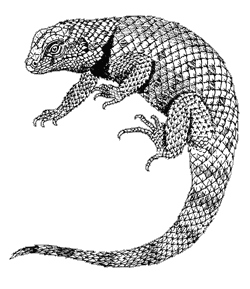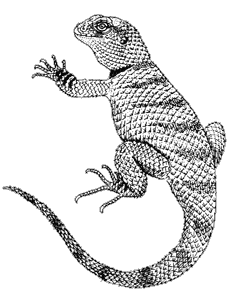Spiny Lizards
desert spiny lizard (Sceloporus magister)
Clark spiny lizard (Sceloporus clarkii)
Order: Squamata
Family: Iguanidae (iguanid lizards)
Spanish name: cachora
Distinguishing Features
 |
These are medium to large lizards with snout-vent lengths ranging from 2¼ to 5¼ inches (63 to 138 mm). These robust lizards have keeled, pointed scales. Background color is usually subdued gray, tan, or blue with a striking wide, purple stripe down the back and single yellow scales scattered on the sides (S. magister), or scattered turquoise scales mixed with tan and brown on the back and sides (S. clarkii). Both species have a dark collar under or around the neck; males have vivid blue throats and under-bellies. Females develop orange to red heads during the breeding season.
Range
S. magister occurs in 6 western states including almost all of Arizona; it occurs east to Texas and south to Sinaloa, Mexico; it is found from sea level to 5000 feet (1520 m). S. clarkii is found in central to southeastern Arizona, southwestern New Mexico, and south to northern Jalisco, Mexico, from sea level to around 6000 feet (1830 m).
 |
Habitat
S. magister and S. clarkii overlap in their use of arid to semiarid regions, lower mountain slopes, and subtropical thornscrub. S. magister, primarily an inhabitant of desertscrub and thornscrub, is found mainly on the ground in rocks and, less frequently, in trees. S. clarkii prefers trees, but also inhabits rocky areas with large boulders; it ranges from rocky Sonoran desertscrub into oak woodland. This species also occurs in tropical deciduous forest and oak-pine forest in Chihuahua, Mexico.
Life History
These two species are insectivorous. Both lay 4 to 24 eggs in the summer (into early fall for S. clarkii) which take 60 to 75 days to hatch.
Comments
Like many other lizards, spiny lizards exhibit metachromatism, which is color change as a function of temperature. When it is cooler, colors are much darker than when the temperature is high. Darker colors increase the amount of heat absorbed from the sun and lighter colors reflect solar radiation.
Meeting One’s Match
Collared lizards can be quite pugnacious. In fact we had a male in one of our enclosures that routinely visited all other similar-sized lizards, just to make sure they knew exactly who was in charge.
When we introduced a male desert spiny lizard to this enclosure, the collared lizard quickly ran over to assert himself. However once he was within a few inches of the spiny lizard he seemed to realize how large this newcomer was. The two lizards took positions next to each other, bodies parallel, then sized up one another with sidelong glances. Eventually they took off in opposite directions. Apparently neither felt superior enough to press the issue.










